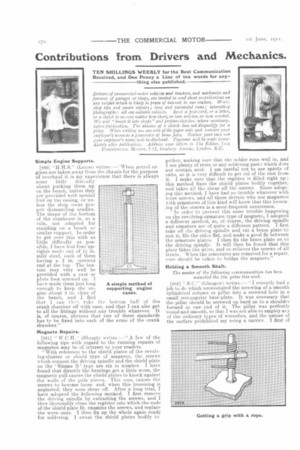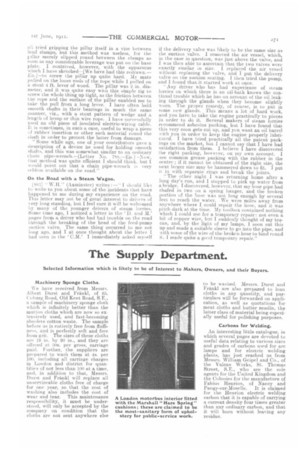Contributions from Drivers and Mechanics.
Page 18

Page 19

If you've noticed an error in this article please click here to report it so we can fix it.
TEN SHILLINGS WEEKLY for the Best Communication Received, and One Penny a Line of ten words for any thing else published.
Drivers of commercial-motor vehicies and tractors, and mechanics and foremen of garages 07 shops, are invited to send short contributions on any subject which is likely to prove of interest to our readers. Workshop tips and smart repairs ; long and successful runs ; interesting photographs : all are suitable subjects. Send a post-card, or a letter, or a sketch to us—no matter how short, or how written, or how worded. We will "knock it into shape" and prepare sketches, where necessary, before publication. The absence of a sketch does not disqualify for a prize. When writing use one side of the paper only and mention your employer's name as a guarantee of bones fides. Neither your own nur your employer's name will be disclosed. Payment will be made immediately after publication. Address your letters to The Editor, THE COMMERCIAL Moroit, 7-15, Rosebery Avenue, London. E.C.
Simple Engine Supports.
[880] "H.H.S." (Luton) writes : —"When petrol engines are taken away from the chassis for the purpose of overhaul it is my experience that there is always some little dinieulty about packing them up on the bench, unless they are provided with special feet on the casing, or unless the shop owns proper dismantling cradles. The shape of the bottom of the crankcase is, as a rule, not adapted for standing on a -bench or similar support. In order to get over this with as little difficulty as possible, I have had four uprights made out of Isf in. mild steel, each of therri having a -1 in. screwed end at the top. The bottom may very well be provided with a cast or plate foot screwed on. I have made them just long enough to keep the engine about 3 in. dear of the bench, and I find that I can then take the bottom half of the crank chamber off with ease, and that I can also get to all the fittings without any trouble whatever. It is, of course, obvious that one of these standards has to he fixed into each of the arms of the crank chamber." A simple method of supporting engine cases.
Magneto Repairs.
[B813 " W.C.H. ' (Slough) writes :—" A few of the following tips with regard to the running repairs of magnetos may be of interest to your readers.
"With reference to the shield plates of the revolving-shutter or shield type of magneto, the screws which connect the driving spindle and the shield plate on the 'Simms B' type are six in number. I have found that directly the bearings get a little worn, the magnetic pull causes the shield plates to knock against the walls of the pole pieces. This soon causes the screws to become loose and, when this loosening is neglected, they soon shear off, After a long trial, I have adopted the following method. I first remove the driving spindle by extracting the screws, arid I then thoroughly clean the register into which the ends of the shield plate fit, examine the screws, and replace the worn ones. I then fix up the whole again ready for soldering. I sweat the shield plates bodily to
gether, making sure that the solder runs well in, and I use plenty of resin or any soldering paste which does not contain acid. I am careful not to use spirits of salts, as it is very difficult to get rid of the rust from it. I make sure that the register is filled right up ; this method fixes the shield plates bodily together, and takes all the shear off the screws. Since adopting this method, I have had no trouble whatever with loose screws, and all those drivers who use magnetos with armatures of this kind will know that this loosening of the screws is a most-frequent occurrence.
" In order to prevent this same trouble happening. on the revolving-armature type of magnetol I adopted a different method, as, of course, the driving spindle and armature are of. quite a different pattern. I first take off the drivieg spindle and cut a brass plate-to suit it, file the sides flat, and make a good fit between the armature plates. I then fix the brass plate on to the driving spindle. It will then be found that this plate rakes the drive, and so relieves the screws of all strain. When the armatures are removed for a repair, care should be taken to bridge the magnets."
Holding a Smooth Shaft.
The sender of the following COmmunuation has been awarded the 10s. prize this week.
[E62] " S.C." (Glasgow) writes :--" I recently had a job to do which necessitated the screwing of a smooth cylindrical column or pillar into a screwed hole in a small rectangular base-plate. It was necessary that the pillar should be screwed up hard on to a shoulder formed at one end of it. The pillar was perfectly round and smooth, so that I was not able to employ aey of the ordinary types of wrenches, and the nature of the surface prohibited my using a carrier. I first of al tried gripping the pillar itself in a vice between lead clamps, but this method was useless, for the pillar merely slipped round between the clamps as soon as any considerable leverage was put On the base plate. I contrived, however, with the apparatus which I have sketched—LWe have had this redrawn.— Eo.i—to screw the pillar up quite hard. My mate pulled OR the loose ends of the rope while I pulled on a stout 4 ft. lever of wood. The pillar was 2 in. diameter, and it was quite easy with this simple rig to screw the whole thing up tight, as the friction between the rope and the surface of the pillar enabled me to take the pull from a long lever. I have often held smooth shafts in their bearings in much the same manner, viz., with a stout pattern of wedge and a length of hemp or thin wire rope.. I have successfully used an old piece of insulated electric-wiring cable. It is sometimes, in such a ease, useful to wrap a piece of rubber insertion or other such material round the shaft in order to protect the latter from damage.
" Some while ago, one of your contributors gave a description of a device he used for holding smooth shafts, and this was somewhat similar to an ordinary chain pipe-wrench.-1.Letter No. 7SS.--En. that method was quite efficient I should think. but I would point out that a chain pipe-wrench is very seldom available on the road."
On the Road with a Steam Wagon.
[St< " W.I1." (Axminster) writes :—" I should like to write to you about some of the incidents that have happened to me during my experience on the road. This letter may not be of great interest to drivers of very long standing, but I feel sure it will be welcomed by many of the younger drivers of steam lorries. Some time ago, I noticed a letter in the ' D. and M.' pages from a driver who had had trouble on the road through the breaking of the head of the feed-pump suction valve. The same thing occurred to me not long ago, and I at once thought about the letter I
had seen in the immediately asked myself
if the delivery valve was likely to be the same size as the suction valve. I removed the air vessel, which, in the case in question, was just above the valve, and 1 was then able to ascertain that the two valves were exactly similar in size. I replace,d the air vessel without replacing the valve, and I put the delivery valve on the suction seating. 1 then tried the pump, and I found that it started work at once.
" Any driver who has had experience of steam lorries on which there is an oil-bath knows the continual trouble which he has on account of the oil leaking through the glands when they become slightly worn. The proper remedy, of course, is to put in some new glands. This means a lot of hard work, and you have to take the engine practically to pieces in order to do it. Several makers of steam lorries
recommend asbestos packing, but 1 have found that
this very soon gets cut up, and you want an oil barrel with you in order to keep the engine properly lubri cated. I have tried practically all the patent pack ings on the market, but I cannot say that I have had satisfaction from them. I believe I have discovered the right. packing, however, on my own account. I use common grease packing with the rubber in the centre; if it cannot be obtained of the right size, the next larger size may be hammered down to fit. I put it in with separate rings and break the joints.
" The other night I was returning home after a long day's run, and I stopped to pick up water from
a bridge. I discovered, however, that my hose pipe had chafed in two on a spring hanger, and the broken portion of the hose was not long enough by several feet to reach the water. We were miles away from anywhere where I could repair the hose, and it was pitch dark at the time. My toolbox contained nothing which I could use for a temporary repair : not even a
bit of copper wire, but I suddenly thought of my teacan, and, by the light of my lamps. I soon cut this up and made a suitable sleeve to go into the pipe, and with some of the wire of the broken hose to bind round
made quite a good temporary repair."




















